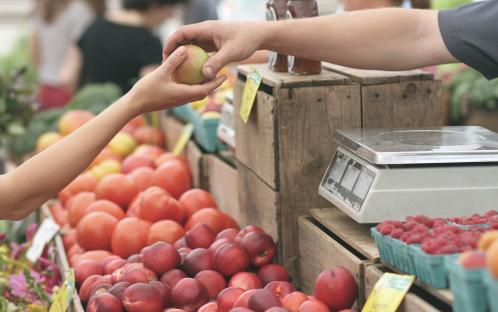Mastering Marketing
Market Season-Ready, Set, Sell
Despite the colder temps and slow start to the growing season, farmers markets, roadside stands and on-farm markets, need to get ready for sunnier days and the first flush of customers looking for fresh local produce, fruits, and other locally produced foods.
How you merchandize yourself and your product will have a dynamic effect on your sales. Now is the time for a quick review of some best marketing practices for you and your marketing staff.
Merchandizing & Displays
We use our senses when making food purchases- what it looks like, how or if it smells, and how it tastes. Produce displays need to convey a sense of abundance and all the product must be visually Grade A.
Be careful not to crush or bruise items on the bottom of displays. For most products, avoid piling them higher than six to eight inches as they might bruise or tumble. Avoid steep pyramid-shaped displays where products continuously roll off the top. Make it easy for the customers to reach the produce. Your display should be no more than an arm's reach in depth, and between knee and eye level in height.
Customers want choice and variety and no one want to pick through the “last few” of anything. As your product sells, consolidate your products into small piles or fewer layers to eliminate bare spots in your display.
Whenever possible, utilize the aromatic traits of any of your products. Cut open a few onions, crush some garlic cloves, or periodically rub the basil to release familiar scents. These can even be kept out of sight but close enough to the product for customers to make the aromatic connection. Vendors cooking products on site can help draw customers to the market through the sounds and smells of cooked items.
Customer Connections
Customer service can be a significant point of differentiation between your farm market or farmer’s market booth and a big grocery store. Keep your product, yourself, and all your display area clean and tidy. Remember customers buy products with their eyes. Take the opportunity to answer customers’ questions and help them get to “know their farmer.“ Listen to their suggestions and ask for their feedback about your products or the market. Give your customers the same level of customer service you would like to receive, and train your employees to do the same.
People buy from people they like. Greet customers with a friendly “hello” and a smile. Be sure to acknowledge your “regular” customers. Customers that purchase direct from producers want to support a local food system. Validate their support by being nice, courteous and thanking them for their business.
Product Sampling in Maryland
We know that product sampling can help boost product sales. In a recent study:
- A University of Kentucky Regional Farm Market Sampling Survey that was comprised of 3,406 responses from market patrons across eight states found that 55 percent of respondents to the survey bought what they sampled even though they hadn't originally planned to do so.
- Among the criteria that influenced sales were vendor friendliness, sample presentation, market atmosphere, sampling with friends or family, and interaction with the vendor.
In Maryland, counties regulate how food sampling is conducted in their jurisdiction at local markets and retail outlets. The University of Maryland‘s Family Consumer Science Educators have developed a document listing product sampling regulations in counties that publish this information. A copy of the Sample Permit Information by County in Maryland is available at: https://go.umd.edu/SamplePermitRegulations
Resources
- Developing a Roadside Farm Market
Penn State University
Prepared by James W. Dunn, professor of agricultural economics, John W. Berry, extension educator in Lehigh County, Lynn Kime, senior extension associate in the Department of Agricultural Economics and Rural Sociology, R. Matthew Harsh, extension educator in Adams County, and Jayson K. Harper, professor of agricultural economics.
Mastering Marketing is produced by Ginger S. Myers and is published periodically containing important seasonal marketing information.
Explore More Mastering Marketing Topics
